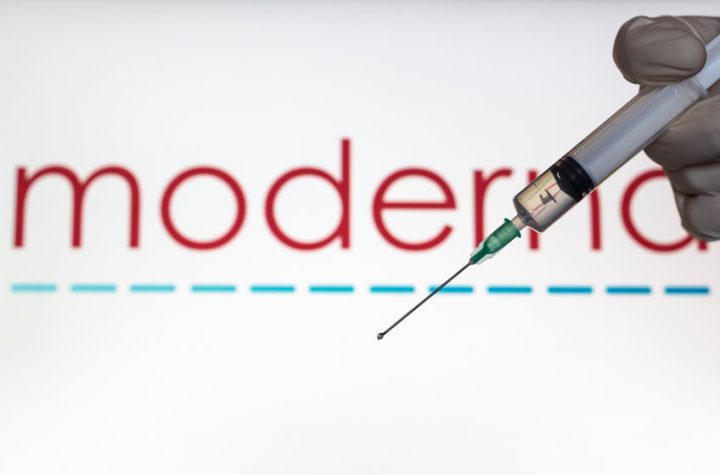
The decision by RBC Capital Markets to downgrade Moderna Inc. (NASDAQ: MRNA) from “Outperform” to “Sector Perform” has sent the stock tumbling by over 6% in pre-market trading on Monday.
This downgrade reflects growing concerns about Moderna’s near-term prospects amid an increasingly challenging market for its flagship COVID-19 and RSV vaccines.
Alongside the downgrade, RBC slashed its price target for the stock from $125 to $90, signifying a cautious stance toward the company’s future.
This revised target still suggests a modest upside from its last closing price, but it underlines the uncertain outlook that Moderna faces after a tumultuous Q2 earnings report.
Q2 earnings in detail
The company’s Q2 FY 2024 earnings, released on August 1, exceeded Wall Street forecasts with a revenue of $241 million, beating expectations by $106.13 million.
Despite this beat, Moderna reported a staggering 73% year-over-year decline in net product sales, primarily driven by the decreased demand for its COVID-19 vaccine, Spikevax.
The biotech firm now projects its annual product sales to be between $3 billion and $3.5 billion, down from an earlier forecast of around $4 billion.
The lowered guidance reflects multiple headwinds, including reduced sales in the European Union and intensifying competition in the U.S. respiratory vaccine market.
Moderna’s peers, such as Pfizer and GSK, have bolstered their positions, leaving Moderna to navigate a landscape fraught with rivalry.
Moderna’s CEO, Stéphane Bancel, has emphasized the company’s commitment to executing its strategy for the upcoming COVID season and the U.S. launch of its RSV vaccine. However, the downgrade by RBC suggests that these efforts might not be enough to offset the prevailing challenges.
Headwinds faced by Moderna
Fundamentally, Moderna faces a complex array of issues. The company’s balance sheet, although strong with a cash reserve of $10.8 billion as of June 30, 2024, reveals vulnerabilities in sustaining profitability amidst declining sales.
The revised guidance has shaken investor confidence, contributing to a sharp decline in Moderna’s stock price, which plummeted from $120 to $86 in just two days following the earnings announcement.
This volatility highlights the market’s apprehension about Moderna’s dependency on its COVID-19 franchise, a concern exacerbated by the broader shift towards an endemic management of the virus.
From a growth perspective, Moderna is at a crossroads. The company is actively expanding its pipeline beyond COVID-19, with notable progress in its respiratory syncytial virus (RSV) and influenza vaccine programs.
The FDA approval of Moderna’s RSV vaccine, mRESVIA, marks a significant milestone, yet the market’s reaction indicates skepticism about its immediate impact on revenue growth.
Moderna’s strategic focus on leveraging its mRNA technology platform to address broader public health challenges remains a pivotal part of its long-term growth narrative.
Despite these growth initiatives, the near-term outlook remains cloudy. Moderna’s aggressive R&D expenditure, projected at approximately $4.5 billion for 2024, underscores its commitment to innovation but also reflects the high stakes involved in developing new therapeutics.
The biotech firm has made strides in oncology with its mRNA-based Individualized Neoantigen Therapy, yet these advancements are not expected to contribute to revenue in the short term.
As Moderna charts its course through this turbulent landscape, the company’s performance will be closely scrutinized.
The next few quarters will be decisive in determining whether Moderna can stabilize its revenue base and capitalize on its pipeline’s potential.
Investors and analysts alike will be watching for signs of recovery and sustained growth in the company’s financial metrics.
With this fundamental overview in mind, it’s time to turn our attention to the technical aspects of Moderna’s stock.
By analyzing key technical indicators and trends, we can gain valuable insights into market sentiment and anticipate how Moderna’s stock might perform in the coming months.
A bounce back on the cards?
Moderna’s stock has seen a substantial decline from its all-time high near 2022 made in late 2021. Although it has tried to bounce back and stabilize several times during this downtrend, it has failed to recapture previous swing highs.
MRNA chart by TradingView
The stock has lost 50% of its value from its previous swing high above $170.47 made in May this year and one-third of its value since the start of the month. Moreover, it is now trading close to its previous support level near $67.5. Hence, the chance for a pullback remains strong.
Therefore, bears looking to enter a fresh short position in the stock must wait for a bounce back to materialize or for the stock to fall below $67.5.
Investors and traders who have a favorable outlook on the company in the short to medium term can capitalize on this recent rapid decline by purchasing the stock below $80 with a stop loss at $67.2. If the momentum shifts even temporarily, the stock can again bounce back to levels above $100 soon.
The post RBC downgrades Moderna and cuts price target by 28%: Should you exit? appeared first on Invezz




More Stories
Ford CEO Jim Farley reveals key advantage over crosstown rivals: ‘No other company has Ford Pro’
Explained: What’s the reason for global stock sell-off and who’s to blame?
Stock exchange bloodbath: Wall Street’s ‘Fear Index’ VIX soars, nears pandemic market rout